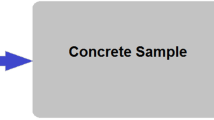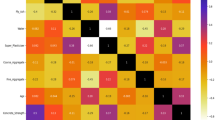Abstract
Concrete is one of the most commonly used construction material on the earth after water. The compressive strength of concrete is an important parameter and is considered in all structural designs. Production of the cement is directly proportional to carbon emissions. The cement content in the concrete can be partially replaced with waste materials like steel fibers, silica fumes, etc. Calculating compressive strength in a laboratory takes huge amount of time, manpower, cost and produces a large amount of wastage. Apart from the constituents of concrete, the compressive strength also depends on various factors such as temperature, mixing, types of aggregate, and quality of the water. The analytical models failed to deal with difficult problems. Artificial intelligence has enough capabilities to deal with such kind of complex problems. In this work, an artificial neural network (ANN) based model has been developed to predict the compressive strength of steel fiber and silica fumes-based concrete. The R-value of the developed model is 0.9948 and the mean absolute percentage error is 5.47%. The mean absolute error and root mean square error of the proposed model is 1.73 MPa and 6.89 MPa, respectively. The developed model is easy to use and reliable to estimate the compressive strength of concrete incorporating silica fumes and steel fibers.
Access this chapter
Tax calculation will be finalised at checkout
Purchases are for personal use only
Similar content being viewed by others
References
Kumar, A., Kapoor, N.R., Arora, H.C., Kumar, A.: Smart cities: a step toward sustainable development. In: Smart Cities, pp. 1–43. CRC Press (2022)
Panesar, D.K.: Supplementary cementing materials. In: Developments in the Formulation and Reinforcement of Concrete, pp. 55–85. Woodhead Publishing (2019). https://doi.org/10.1016/B978-0-08-102616-8.00003-4
Wang, J., Xie, J., He, J., Sun, M., Yang, J., Li, L.: Combined use of silica fume and steel fibre to improve fracture properties of recycled aggregate concrete exposed to elevated temperature. J. Mater. Cycles Waste Manag. 22(3), 862–877 (2020). https://doi.org/10.1007/s10163-020-00990-y
Nili, M., Afroughsabet, V.: The combined effect of silica fume and steel fibers on the impact resistance and mechanical properties of concrete. Int. J. Impact Eng. 37(8), 879–886 (2010). https://doi.org/10.1016/j.ijimpeng.2010.03.004
Xie, J., et al.: Experimental study on the compressive and flexural behavior of recycled aggregate concrete modified with silica fume and fibers. Constr. Build. Mater. 178, 612–623 (2018). https://doi.org/10.1016/j.conbuildmat.2018.05.136
Nili, M., Afroughsabet, V.: Property assessment of steel–fiber reinforced concrete made with silica fume. Constr. Build. Mater. 28(1), 664–669 (2012). https://doi.org/10.1016/j.conbuildmat.2011.10.027
Kedia, S., Bhushan, M.: Prediction of mortality from heart failure using machine learning. In: 2022 2nd International Conference on Emerging Frontiers in Electrical and Electronic Technologies (ICEFEET), pp. 1–6. IEEE (2022). https://doi.org/10.1109/ICEFEET51821.2022.9848348
Verma, U., Garg, C., Bhushan, M., Samant, P., Kumar, A., Negi, A.: Prediction of student’s academic performance using Machine Learning Techniques. In: 2022 International Mobile and Embedded Technology Conference (MECON), pp. 151–156. IEEE (2022). https://doi.org/10.1109/MECON53876.2022.9751956
Kapoor, N.R., Kumar, A., Arora, H.C., Kumar, A.: Structural health monitoring of existing building structures for creating green smart cities using deep learning. In: Recurrent Neural Networks, pp. 203–232. CRC Press (2022)
Cemalgil, S., Gül, E., Onat, O., Aruntaş, H.Y.: A novel prediction model for durability properties of concrete modified with steel fiber and Silica Fume by using Hybridized GRELM. Constr. Build. Mater. 341, 127856 (2022). https://doi.org/10.1016/j.conbuildmat.2022.127856
Khan, K., Ahmad, W., Amin, M.N., Ahmad, A., Nazar, S., Alabdullah, A.A.: Compressive strength estimation of steel-fiber-reinforced concrete and raw material interactions using advanced algorithms. Polymers 14(15), 3065 (2022). https://doi.org/10.3390/polym14153065
Kumar, A., et al.: Prediction of FRCM–concrete bond strength with machine learning approach. Sustainability 14(2), 845 (2022). https://doi.org/10.3390/su14020845
Kapoor, N.R., et al.: Machine learning-based CO2 prediction for office room: a pilot study. Wirel. Commun. Mob. Comput. 2022 (2022). https://doi.org/10.1155/2022/9404807
Kumar, A., et al.: Compressive strength prediction of lightweight concrete: machine learning models. Sustainability 14(4), 2404 (2022). https://doi.org/10.3390/su14042404
Kumar, A., Arora, H.C., Kapoor, N.R., Kumar, K.: Prognosis of compressive strength of fly-ash-based geopolymer-modified sustainable concrete with ML algorithms. Struct. Concr. (2022). https://doi.org/10.1002/suco.202200344
Kumar, A., Mor, N.: An approach-driven: use of artificial intelligence and its applications in civil engineering. In: Manoharan, K.G., Nehru, J.A., Balasubramanian, S. (eds.) Artificial Intelligence and IoT: Smart Convergence for Eco-friendly Topography, pp. 201–221. Springer, Singapore (2021). https://doi.org/10.1007/978-981-33-6400-4_10
Kapoor, N.R., Kumar, A., Alam, T., Kumar, A., Kulkarni, K.S., Blecich, P.: A review on indoor environment quality of Indian school classrooms. Sustainability 13(21), 11855 (2021). https://doi.org/10.3390/su132111855
Kumar, K., Saini, R.P.: Development of correlation to predict the efficiency of a hydro machine under different operating conditions. Sustain. Energy Technol. Assess. 50, 101859 (2022). https://doi.org/10.1016/j.seta.2021.101859
Kumar, A., Arora, H.C., Mohammed, M.A., Kumar, K., Nedoma, J.: An optimized neuro-bee algorithm approach to predict the FRP-concrete bond strength of RC beams. IEEE Access 10, 3790–3806 (2021). https://doi.org/10.1109/ACCESS.2021.3140046
Köksal, F., Altun, F., Yiğit, İ, Şahin, Y.: The combined effect of silica fume and steel fiber on the mechanical properties of high strength concretes. Constr. Build. Mater. 22(8), 1874–1880 (2008). https://doi.org/10.1016/j.conbuildmat.2007.04.017
Giner, V.T., Baeza, F.J., Ivorra, S., Zornoza, E., Galao, Ó.: Effect of steel and carbon fiber additions on the dynamic properties of concrete containing silica fume. Mater. Des. 34, 332–339 (2012). https://doi.org/10.1016/j.matdes.2011.07.068
Ali, B., Raza, S.S., Hussain, I., Iqbal, M.: Influence of different fibers on mechanical and durability performance of concrete with silica fume. Struct. Concr. 22(1), 318–333 (2021). https://doi.org/10.1002/suco.201900422
Boulekbache, B., Hamrat, M., Chemrouk, M., Amziane, S.: Flexural behavior of steel fiber-reinforced concrete under cyclic loading. Constr. Build. Mater. 126, 253–262 (2016). https://doi.org/10.1016/j.conbuildmat.2016.09.035
Yoo, D.Y., Yoon, Y.S., Banthia, N.: Predicting the post-cracking behavior of normal-and high-strength steel-fiber-reinforced concrete beams. Constr. Build. Mater. 93, 477–485 (2015). https://doi.org/10.1016/j.conbuildmat.2015.06.006
Lin, W.T., Huang, R., Lee, C.L., Hsu, H.M.: Effect of steel fiber on the mechanical properties of cement-based composites containing silica fume. J. Mar. Sci. Technol. 16(3), 7 (2008). https://doi.org/10.51400/2709-6998.2010
Hasan-Nattaj, F., Nematzadeh, M.: The effect of forta-Ferro and steel fibers on mechanical properties of high-strength concrete with and without silica fume and nano-silica. Constr. Build. Mater. 137, 557–572 (2017). https://doi.org/10.1016/j.conbuildmat.2017.01.078
Şahin, Y., Köksal, F.: The influences of matrix and steel fiber tensile strengths on the fracture energy of high-strength concrete. Constr. Build. Mater. 25(4), 1801–1806 (2011). https://doi.org/10.1016/j.conbuildmat.2010.11.084
Saba, A.M., et al.: Strength and flexural behavior of steel fiber and silica fume incorporated self-compacting concrete. J. Market. Res. 12, 1380–1390 (2021). https://doi.org/10.1016/j.jmrt.2021.03.066
Amin, M., Zeyad, A.M., Tayeh, B.A., Agwa, I.S.: Effect of ferrosilicon and silica fume on mechanical, durability, and microstructure characteristics of ultra-high-performance concrete. Constr. Build. Mater. 320, 126233 (2022). https://doi.org/10.1016/j.conbuildmat.2021.126233
Dawood, E.T., Ramli, M.: Effects of the fibers on the properties of high-strength flowing concrete. KSCE J. Civ. Eng. 18(6), 1704–1710 (2014). https://doi.org/10.1007/s12205-014-0170-6
Mousavi, S.M., Ranjbar, M.M., Madandoust, R.: Combined effects of steel fibers and water to cementitious materials ratio on the fracture behavior and brittleness of high strength concrete. Eng. Fract. Mech. 216, 106517 (2019). https://doi.org/10.1016/j.engfracmech.2019.106517
Najim, K.B., Saeb, A., Al-Azzawi, Z.: Structural behavior and fracture energy of recycled steel fiber self-compacting reinforced concrete beams. J. Build. Eng. 17, 174–182 (2018). https://doi.org/10.1016/j.jobe.2018.02.014
Afroughsabet, V., Ozbakkaloglu, T.: Mechanical and durability properties of high-strength concrete containing steel and polypropylene fibers. Constr. Build. Mater. 94, 73–82 (2015). https://doi.org/10.1016/j.conbuildmat.2015.06.051
Gesoğlu, M., Güneyisi, E., Alzeebaree, R., Mermerdaş, K.: Effect of silica fume and steel fiber on the mechanical properties of the concretes produced with cold bonded fly ash aggregates. Constr. Build. Mater. 40, 982–990 (2013). https://doi.org/10.1016/j.conbuildmat.2012.11.074
Xie, J., Fang, C., Lu, Z., Li, Z., Li, L.: Effects of the addition of silica fume and rubber particles on the compressive behavior of recycled aggregate concrete with steel fibers. J. Clean. Prod. 197, 656–667 (2018). https://doi.org/10.1016/j.jclepro.2018.06.237
Author information
Authors and Affiliations
Corresponding author
Editor information
Editors and Affiliations
Rights and permissions
Copyright information
© 2023 The Author(s), under exclusive license to Springer Nature Switzerland AG
About this paper
Cite this paper
Sahota, S.S., Arora, H.C., Kumar, A., Kumar, K., Rai, H.S. (2023). ML-Based Computational Model to Estimate the Compressive Strength of Sustainable Concrete Integrating Silica Fume and Steel Fibers. In: Garg, L., et al. Key Digital Trends Shaping the Future of Information and Management Science. ISMS 2022. Lecture Notes in Networks and Systems, vol 671. Springer, Cham. https://doi.org/10.1007/978-3-031-31153-6_20
Download citation
DOI: https://doi.org/10.1007/978-3-031-31153-6_20
Published:
Publisher Name: Springer, Cham
Print ISBN: 978-3-031-31152-9
Online ISBN: 978-3-031-31153-6
eBook Packages: Intelligent Technologies and RoboticsIntelligent Technologies and Robotics (R0)




